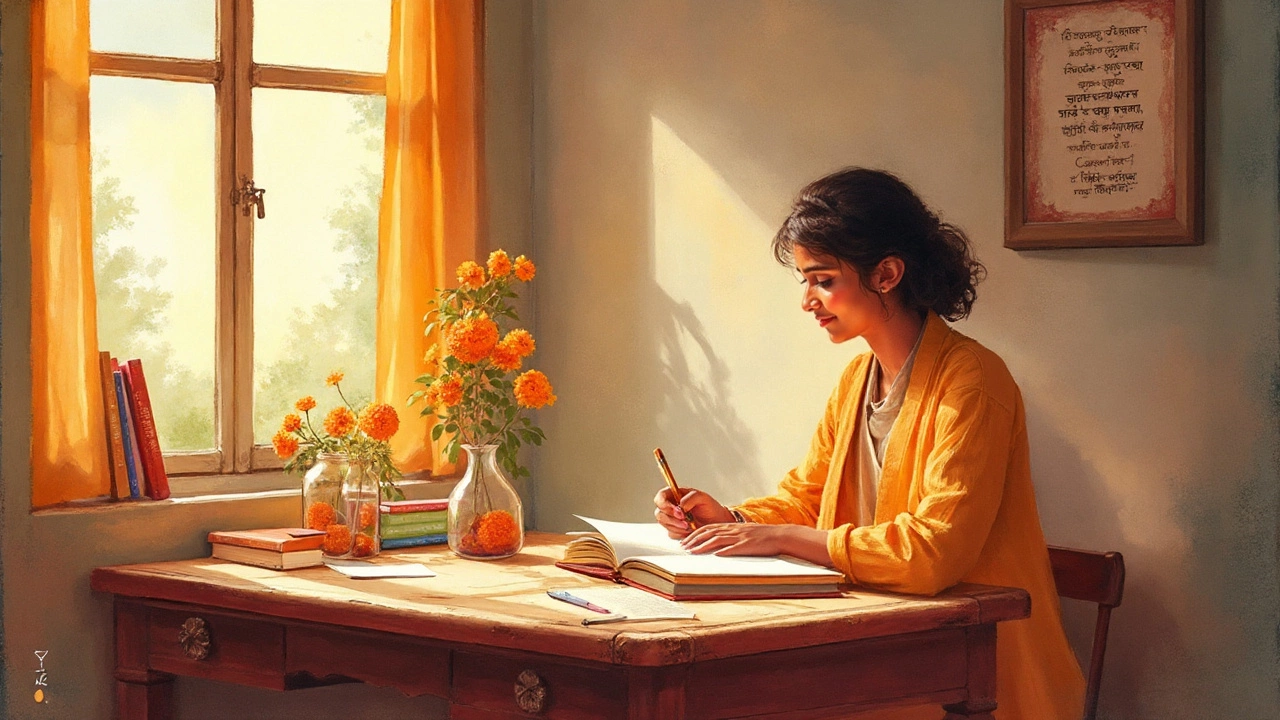What Is a Short Poem Called? Short Poem Types, Examples & Fun Facts
 Aug, 3 2025
Aug, 3 2025
Imagine you stumble upon a line or two so powerful that it knocks you back, a poem that captures a lifetime in a handful of words. That’s the true magic of short poems. People ask, “What is a short poem called?” and while it sounds simple, the answer is surprisingly layered. Short poems come in more shapes, styles, and flavors than most realize, and they’ve been capturing minds for thousands of years. But don’t expect just a one-word answer—there’s a whole world packed into those few lines.
The Basics: What Is a Short Poem Called?
Short poems have their own special place in literature. If you want to get technical, the broad answer is “short poem,” but specific types have unique names, rules, and vibes. The most famous? The haiku. It’s a Japanese poem with just 17 syllables: 5 in the first line, 7 in the second, 5 in the third. But that’s just scratching the surface. There’s the couplet, a dynamic two-liner often packed with wit and punch. Quatrains, limericks, epigrams—this space is crowded with contenders. Each form gives the writer a unique set of limits, which usually leads to something clever or memorable.
You’ll see poets use the word “micropoetry” for super-short poetic bursts, especially online or on platforms like Twitter, where character counts rule the game. Back in the day, before TikTok or Instagram, people still loved these quick hits of poetic flavor. Think of William Blake’s “Auguries of Innocence,” which starts: “To see a world in a grain of sand…” That’s less than a tweet but feels infinite.
Even in the age of endless scrolling, short poems have a unique strength—they fit our shrinking attention spans but still hit hard. So, call it a haiku, couplet, limerick, or just a short poem, but appreciate how much meaning poets cram into so little space. It’s like watching someone pack too many clothes into a tiny suitcase—and still close the zip.
Popular Types of Short Poems: Haikus, Couplets, and More
Let’s get specific. The best-known short poetic form is the haiku. These little gems originated in Japan, but now they’re everywhere—Instagram bios, school projects, even advertising copy. The strict syllable count forces writers to keep it tight, often focusing on nature or emotions. A classic haiku could look like this:
- Old pond— A frog jumps in, Sound of water.
On the other hand, there’s the couplet. This form is simple: just two lines, usually rhyming, but sometimes not. Think about all the couplets floating in your head from kids’ books or nursery rhymes. “Jack and Jill went up the hill/To fetch a pail of water.” They’re catchy, and the rhyme makes them stick.
Limericks step up the playfulness. They have five lines, a very specific rhythm, and they almost always end with a twist or punchline—think of the classic “There once was a man from Nantucket…” Limericks aren’t just for kids, either. Poets use them to play with language, humor, and double meanings.
Then come quatrains—a four-line poem, often with a rhyme scheme (ABAB is common). Emily Dickinson and other famous poets have used quatrains for powerful one-stanza poems. And let’s not forget epigrams—short, witty poems with a twist at the end. Martial, a Roman poet from the first century, was dropping epigrams long before Twitter had a blue tick.
Here’s a table that puts these short poem types side by side so you can see how they compare:
| Type | Lines | Main Features |
|---|---|---|
| Haiku | 3 | 5-7-5 syllables, nature focus |
| Couplet | 2 | Often rhymed, punchy |
| Limerick | 5 | AABBA rhyme, humorous |
| Quatrain | 4 | Varying rhyme, flexible |
| Epigram | 2-4 | Witty, sharp, twist ending |
| Micropoem | 1+ | Fragment, experimental |
So, if you’re thinking of writing a short poem yourself, you’ve got plenty to pick from. Short doesn’t mean easy—it’s even trickier to pack a punch in a few words. But the payoff is huge when readers nod along, instantly getting your meaning.

Famous Short Poems and Their Impact
Short poems have had a pretty outsized impact on the world. Consider Basho’s haikus, still quoted almost 400 years later. A few lines, a timeless feeling. Or Emily Dickinson, who could deliver the punch of a novel in just four or five lines. “Because I could not stop for Death/He kindly stopped for me.” There’s a chill in that simplicity.
William Carlos Williams’s “This Is Just To Say” barely gets started before it’s done, yet it stirs up an avalanche of emotions over something as simple as a stolen plum. Ezra Pound’s “In a Station of the Metro,” just 14 words, blends imagery that lingers way longer than a 14-page essay.
Modern poets have carried this tradition forward, especially on social media. Rupi Kaur’s short, lowercase poems soared in popularity on Instagram. She proved you don’t need fancy language or length for poetry to connect—realness and brevity get the job done.
It’s not just in English, either. In India, Urdu shayari often hits hard in just a few lines, mixing love, heartbreak, and wisdom. Mirza Ghalib or Rahat Indori could drop a couplet and send thousands into introspection. Short poems also work well in oral storytelling, from the rural Indian doha to the crisp English epigram. Poems that people can memorize easily—even recite at will—often stick around the longest. That’s why lines and couplets from short poems wind their way into conversation and quotes everywhere, from Bollywood songs to rap lyrics.
Sometimes, you’ll see an anonymous short poem or quote hanging in a classroom, scrawled on a bathroom wall, or posted in someone’s Instagram story. The impact is instant: you remember it, maybe even change your own behavior or thinking for a moment. That’s poetry doing its job, in a microdose.
Tips for Writing an Effective Short Poem
Writing a short poem sounds easy, but it’s like packing your whole day into five seconds. Every word has to work hard. First, find a single image or emotion—don’t try to cram in too much. Imagine the punchline of a joke or the hook in a song. That’s what your short poem should feel like. The best haikus don’t use flowery language—they give you a picture, a feeling, maybe a surprise at the end.
Stick to simple words. Short poems are not the place to show off your vocabulary. Instead, focus on clarity and impact. Ask yourself, “Will someone get my meaning right away?” If not, trim some words or swap them out for something clearer. If you’re writing a haiku, count your syllables—don’t cheat. The challenge is half the fun.
Use strong imagery and fresh comparisons. It’s tempting to fall back on clichés, but try to describe something ordinary in a way nobody else has. For editing, read your poem aloud. Hearing it helps spot clunky lines, awkward sounds, or possible improvements. If you trip over a line, your reader probably will, too.
Here’s a quick exercise: take a feeling—say, “missing someone”—and write it in three short lines. No need for rhyme, just image and emotion. That’s how many great micro poems start. For inspiration, look at Twitter poets under hashtags like #micropoetry or #haiku. You’ll see everything from classic forms to wild experiments with line breaks and punctuation.
- Keep it visual—show, don’t tell.
- Stick to one central idea or emotion.
- Play with structure—try a haiku, couplet, or epigram.
- Revise until every word feels sharp and necessary.
- Test your poem on friends: do they get what you mean right away?
Remember, great short poems often feel obvious in hindsight, like, “How did I not think of that?” But only after the writer’s put in the work, distilling a big idea into a few distilled drops.

Why Short Poems Stick: Science, Psychology, and Society
There’s a reason short poems hit so hard. Science shows we remember information better in small, bite-sized chunks. That’s called “chunking,” and it’s how the brain stores phone numbers, song lyrics, or slogans. Short lines, especially if they rhyme, are easier to recall. That’s why you remember old ad jingles or Bollywood catchphrases even years later.
In a world full of endless content, short poems cut through the noise. They fit on postcards, t-shirts, and even coffee mugs. A study by Harvard’s psychology department found that people were more likely to remember and repeat two-line rhymed poems than longer, prose-based quotes. Rhymes and rhythm create an earworm effect, helping lines burrow into memory.
On social media, attention spans are tiny—Microsoft found the average is just 8 seconds. Short poems don’t ask for more than you can give. Ever seen a micro poem go viral? They’re shareable, portable, and sometimes even meme-able. A line from a poem works as a tweet or an Instagram caption like magic. In the 2020s, the rise of "poetry shorts" on TikTok and micro-literature accounts on Instagram and Threads have added even more momentum to this style.
Society values efficiency now. We want a quick hit of meaning, something to make us pause or smile in the middle of doom-scrolling. That’s why you find short poems popping up in tech advertisements, music, and even at the start of YouTube videos. Poets and writers know this—and embrace the power of brevity. Schools in India and around the globe now sometimes use short-form poems as creative assignments because kids can see results fast. It’s less about length and more about quality—what you’re able to say, not how long it takes to say it.
But there’s a deeper reason. Short poems offer people a way to be heard, even if they don’t have the time or confidence to write a full book. It’s instant, honest expression. Writers facing tough emotions—grief, love, joy, regret—have just enough space to share without oversharing. Every word counts, so each one feels more personal and impactful. And that’s the biggest reason these poems stick: they sound like little truths, whispered directly to the reader.